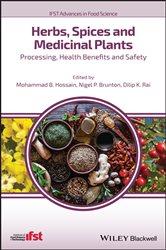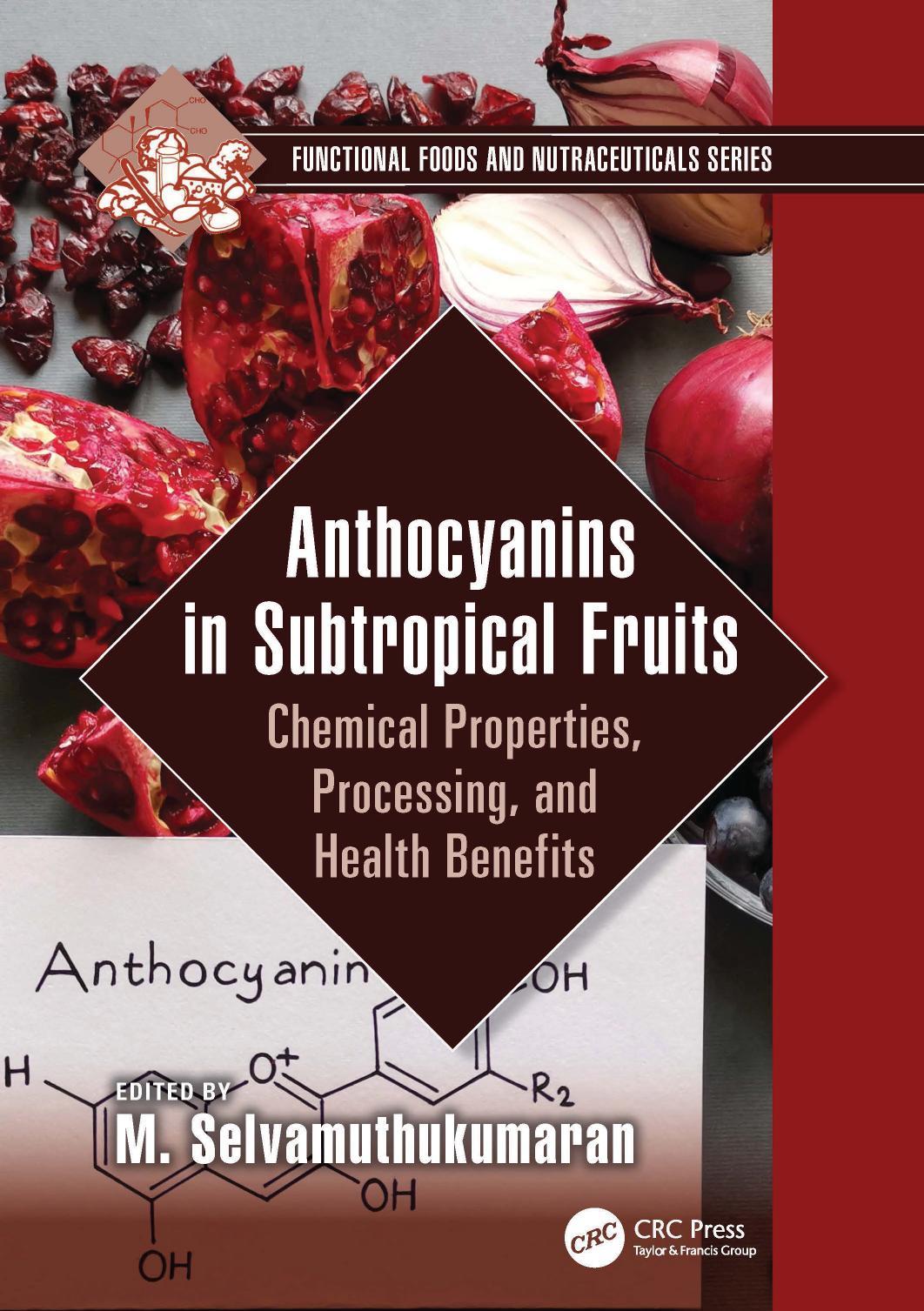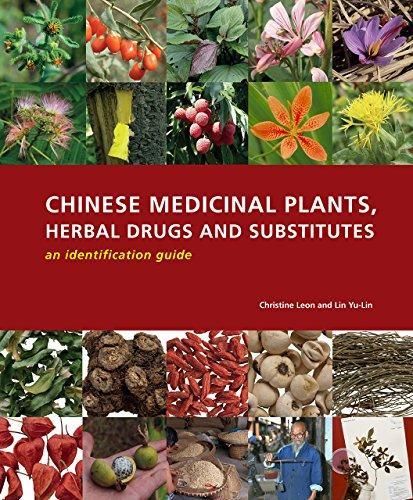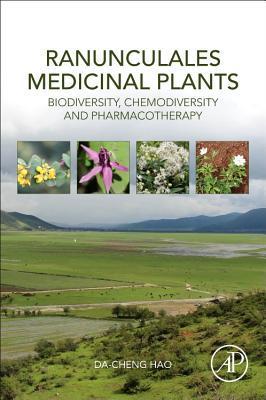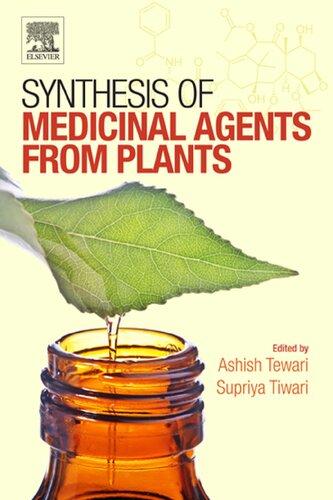Herbs,Spicesand MedicinalPlants: Processing,Health BenefitsandSafety
Editedby
MohammadB.Hossain TeagascFoodResearchCentre Ashtown,Ireland
NigelP.Brunton SchoolofAgricultureandFoodScience UniversityCollegeDublin Dublin,Ireland
DilipK.Rai TeagascFoodResearchCentre Ashtown,Ireland
Thiseditionfirstpublished2020 ©2020JohnWiley&SonsLtd
Allrightsreserved.Nopartofthispublicationmaybereproduced,storedinaretrievalsystem,ortransmitted,in anyformorbyanymeans,electronic,mechanical,photocopying,recordingorotherwise,exceptaspermittedby law.Adviceonhowtoobtainpermissiontoreusematerialfromthistitleisavailableat http://www.wiley.com/go/ permissions
TherightofMohammadB.Hossain,NigelP.Brunton,andDilipK.Raitobeidentifiedastheauthorsofthe editorialmaterialinthisworkhasbeenassertedinaccordancewithlaw.
RegisteredOffices
JohnWiley&Sons,Inc.,111RiverStreet,Hoboken,NJ07030,USA
JohnWiley&SonsLtd,TheAtrium,SouthernGate,Chichester,WestSussex,PO198SQ,UK
EditorialOffice
TheAtrium,SouthernGate,Chichester,WestSussex,PO198SQ,UK
Fordetailsofourglobaleditorialoffices,customerservices,andmoreinformationaboutWileyproductsvisitusat www.wiley.com
Wileyalsopublishesitsbooksinavarietyofelectronicformatsandbyprint-on-demand.Somecontentthat appearsinstandardprintversionsofthisbookmaynotbeavailableinotherformats.
LimitofLiability/DisclaimerofWarranty
Whilethepublisherandauthorshaveusedtheirbesteffortsinpreparingthiswork,theymakenorepresentations orwarrantieswithrespecttotheaccuracyorcompletenessofthecontentsofthisworkandspecificallydisclaimall warranties,includingwithoutlimitationanyimpliedwarrantiesofmerchantabilityorfitnessforaparticular purpose.Nowarrantymaybecreatedorextendedbysalesrepresentatives,writtensalesmaterialsorpromotional statementsforthiswork.Thefactthatanorganization,website,orproductisreferredtointhisworkasacitation and/orpotentialsourceoffurtherinformationdoesnotmeanthatthepublisherandauthorsendorsethe informationorservicestheorganization,website,orproductmayprovideorrecommendationsitmaymake.This workissoldwiththeunderstandingthatthepublisherisnotengagedinrenderingprofessionalservices.Theadvice andstrategiescontainedhereinmaynotbesuitableforyoursituation.Youshouldconsultwithaspecialistwhere appropriate.Further,readersshouldbeawarethatwebsiteslistedinthisworkmayhavechangedordisappeared betweenwhenthisworkwaswrittenandwhenitisread.Neitherthepublishernorauthorsshallbeliableforany lossofprofitoranyothercommercialdamages,includingbutnotlimitedtospecial,incidental,consequential,or otherdamages.
LibraryofCongressCataloging-in-PublicationData
Names:Hossain,MohammadB.,1978-editor.|Brunton,NigelP.,editor.| Rai,DilipK.,1972-editor.
Title:Herbs,spicesandmedicinalplants:processing,healthbenefitsand safety/editedbyMohammadB.Hossain,NigelP.Brunton,andDilipK.Rai Description:Hoboken,NJ:Wiley-Blackwell,2020.| Series:IFSTadvancesinfoodsciencebookseries|Includes bibliographicalreferencesandindex.
Identifiers:LCCN2019058270(print)|LCCN2019058271(ebook)|ISBN 9781119036616(hardback)|ISBN9781119036647(adobepdf)|ISBN 9781119036630(epub)
Subjects:LCSH:Pharmacognosy.|Medicinalplants–Preservation.| Spices–Therapeuticuse.|Herbs–Therapeuticuse.|Plantextracts.
Classification:LCCRS164.H3862020(print)|LCCRS164(ebook)|DDC 615.3/21–dc23
LCrecordavailableathttps://lccn.loc.gov/2019058270
LCebookrecordavailableathttps://lccn.loc.gov/2019058271
CoverDesign:Wiley
CoverImages:Yellowflowers©LFRabanedo/Shutterstock, Spicesandherbs©fcafotodigital/GettyImages, Plums©HelmutMeyerzurCapellen/GettyImages
Setin9.5/11.5ptTimesTenLTstd-RomanbySPi-Global,Chennai,India
10987654321
ListofContributorsxi
1ThermalProcessingofHerbsandSpices1
AnjaliH.Kurup,ShwetaDeotale,AshishRawson,andAnkitPatras
1.1Introduction1
1.2ThermalProcessingofSpices2
1.2.1CookingandRoastingofSpices2
1.2.2Blanching9
1.2.3High-PressureSteamTreatment10
1.2.4ElectromagneticEnergy(Microwave)Treatment12
1.3ThermalProcessingofHerbs13 1.4Conclusion16 References17
2Non-ThermalProcessingofHerbsandSpices23 CamilaA.Perussello
2.1Introduction23
2.2Ozone 25
2.3Irradiation28
2.4PulsedElectricField31
2.5PulsedLight33
2.6FumigationwithEthyleneDioxide34
2.7HighPressureCO2 CoupledwithUltrasound36
2.8ColdPlasma37
2.9Conclusions39 References39
3RecentDevelopmentsinHigh-QualityDryingofHerbsandSpices45 WeiJin,MinZhang,WeifengShi,andArunS.Mujumdar
3.1Introduction45
3.2NovelCombinedDryingMethods46
3.2.1Solar-RelatedCombinedDryingMethods47
3.2.2Microwave-RelatedCombinedDryingMethods53
3.2.3OtherEnergySources-RelatedCombinedDryingMethods59
3.3OtherInnovativeDryingMethods61
3.4ConclusionandSuggestionsforFutureResearch62 Acknowledgments63 References63
4ConventionalExtractionTechniquesforBioactiveCompoundsfromHerbs andSpices69
MdAbuBakarSiddique,KaterinaTzima,DilipK.Rai,andNigelBrunton
4.1Introduction69
4.2PrinciplesofExtraction70
4.2.1Solid–LiquidExtraction70
4.2.2Liquid–LiquidExtraction74
4.3FactorsAffectingExtraction76
4.3.1Solid–LiquidExtraction76
4.3.2Liquid–LiquidExtraction79
4.3.3SoxhletExtraction82
4.4OptimizedExtractionTechniquesforHerbsandSpices85 4.5Conclusion85 References88
5NovelExtractionTechniquesforBioactiveCompoundsfromHerbsand Spices95
AndreaP.Sánchez-Camargo,LidiaMontero,JoseA.Mendiola,M.Herrero, andE.Ibáñez
5.1Introduction95
5.2PressurizedLiquidExtraction(PLE)96
5.2.1DescriptionoftheTechnique96
5.2.2ApplicationsofPLEtoHerbsandSpices98
5.3SupercriticalFluidExtraction(SFE)101
5.3.1DescriptionoftheTechnique101
5.3.2ApplicationsofSFEtoHerbsandSpices103
5.4Ultrasound-AssistedExtraction(UAE)105
5.4.1DescriptionoftheTechnique105
5.4.2ApplicationsofUAEtoHerbsandSpices106
5.5Microwave-AssistedExtraction(MAE)108
5.5.1DescriptionoftheTechnique108
5.5.2ApplicationsofMAEtoHerbsandSpices109
5.6Enzyme-AssistedExtraction(EAE)112
5.6.1DescriptionoftheTechnique112
5.6.2ApplicationsofEAEtoHerbsandSpices113
5.7IntegrationofDifferentExtractionTechniques115
5.7.1Ultrasound–Microwave-AssistedExtraction(UMAE)115
5.7.2Enzyme-Based–Ultrasound–Microwave-AssistedExtraction(EUMAE)116
5.7.3SupercriticalFluidExtraction–PressurizedFluidExtraction(SFE–PLE)116
5.7.4SupercriticalFluidExtractionAssistedbyUltrasound(SFE–UAE)118
5.8ConclusionsandFutureOutlook120 Acknowledgments121 References121
6ApproachestoAnalyticalTechniques–CharacterizingPhytochemicalsin Verbascum spp.129 Anna-MariaKeaveney,AmbroseFurey,andBrigidLucey
6.1Introduction129
6.2TheChallengeofComplexity134
6.3ExtractionProcesses137
6.4SeparationandDetection140
6.4.1ThinLayerChromatography(TLC)andHigh-PerformanceThinLayer Chromatography(HPTLC)143
6.4.2High-PerformanceLiquidChromatography(HPLC)146
6.4.3GasChromatography(GC)147
6.4.4IonExchangeChromatography,SizeExclusionChromatography,Capillary Electrophoresis147
6.4.5HyphenatedTechniques(LC–MS,GC–MS,LC–NMR)148
6.4.6TLCBioautography149
6.4.7SpectroscopicMethods150
6.5ChemicalCharacterization151
6.5.1IridoidGlycosides153
6.5.2Flavonoids158
6.5.3Phenylethanoid/PhenylproponoidGlycosides159
6.5.4Saponins160
6.5.5SpermineAlkaloids161
6.5.6Polysaccharides161
6.5.7OtherConstituents162
6.6Discussion162
6.7Conclusion165
FundingandAcknowledgments166 References166
7PurificationandIsolationTechniquesforEnrichmentofBioactive PhytochemicalsfromHerbsandSpices177 RamónAznarandDilipK.Rai
7.1Introduction177
7.2HowtoApproachPurificationandIsolation178
7.3PurificationTechniques180
7.3.1Liquid–LiquidFractionation180
7.3.2Solid-PhaseExtraction181
7.3.3PreparativeLiquidChromatography185
7.3.4Hydrolysis194
7.3.5MembraneFiltration195
7.3.6Recrystallization195
7.3.7OtherTechniques197
7.4ExampleofPurificationandIsolation198
7.5ChallengesandFutureTrends199 References201
8MedicinalPropertiesofHerbsandSpices:Past,Present,andFuture207 CeliaRodríguez-PérezandRamónAznar
8.1Introduction207
8.2HistoricalUsesofHerbsandSpices208
8.3HerbsandSpicesinthePreventionandTreatmentofChronicDiseases210
8.3.1AnticancerProperties210
8.3.2Anti-inflammatoryProperties230
8.3.3AntidiabeticProperties231
8.3.4AntiobesityProperties233
8.3.5HypolipidemicProperties233
8.3.6InfluenceonDigestiveStimulation235
8.3.7AntihypertensiveProperties236
8.3.8ProtectionAgainstAlzheimer’sDisease236
8.3.9HepatoprotectiveProperties237
8.4InteractionandPotentialSideEffects238
8.5FutureTrends239 Abbreviations239 References240
9SynergyinWholePlantMedicine: Crataegus spp.:AnExample251
MaryC.Tassell,Anne-MariaKeaveney,RosariKingston,DeirdreGilroy, MaryLehane,BrigidLucey,andAmbroseFurey
9.1Introduction251 9.2CardiovascularDiseases252
9.3 Crataegus spp.252 9.4Synergy254
9.4.1Dose–EffectApproaches257
9.4.2Effect-BasedApproaches260 9.5MechanismsofAction262
9.5.1MultitargetEffects264
9.5.2PharmacokineticorPhysicochemicalEffects(EnhancedBioavailability, ImprovedSolubility,orImprovedResorptionRate)264
9.5.3InteractionswiththeAntibioticResistanceMechanismsofBacteria264
9.5.4ImprovedEffectivenessby,forExample,EliminationorNeutralizationof AdverseorToxicEffects265
9.6 Crataegus spp.–aReview266
9.6.1PublishedPapers266
9.6.2MultitargetEffects270 9.7GeneralConsiderations272
9.7.1LackofaPreciseDefinitionforCombinationEffects272
9.7.2HeterogeneityofStudies273
9.7.3PreparationsUsed273
9.7.4AbsorptionandBioavailability274 9.8Conclusion275
FundingandAcknowledgments276 References276
10PotentialApplicationsofPolyphenolsfromHerbsandSpicesinDairy ProductsasNaturalAntioxidants283
KaterinaTzima,NigelP.Brunton,AlkaChoudhary,andDilipK.Rai 10.1Introduction283
10.2ImplicationsintheUseofHerbsandSpicesasNaturalAntioxidantsinMilkand DairyProducts284
10.2.1EffectofPhenolicConcentrationonMilkandDairyProducts284
10.2.2EffectofPhenolicsontheOrganolepticPropertiesofDairyProducts285
10.2.3EffectofPhenolicsontheProteinStabilityofMilkandDairyProducts287
10.2.4EffectofIndigenousAntioxidantCompounds(Chlorophyll)ontheColor ofMilkandDairyProducts288
10.3MilkandDairyProductsasCarriersofNaturalAntioxidants288
10.3.1ButterandDairySpreadsasCarriersofNaturalAntioxidants289
10.3.2CheeseasaCarrierofNaturalAntioxidants290
10.3.3GheeasaCarrierofNaturalAntioxidants291
10.3.4SandeshasaCarrierofNaturalAntioxidants292
10.3.5YogurtasaCarrierofNaturalAntioxidants293
10.3.6IceCreamasaCarrierofNaturalAntioxidants294 Abbreviations294 References294
11BioticandAbioticSafetyConcernsforHerbsandSpices301 ManjaZecandMariaGlibetic
11.1NaturalProductsinScience–“GenerallyRecognizedasSafe?”303
11.2HerbsandSpices–ReportedAdverseEffectsandAdverseDrugReactions304 11.3(A)BioticFactorsIncorporatedintheFoodchainandInfluencingtheSafetyof HerbalConsumption306
11.4HerbalProductSafetyConcerns–AdvancesinIdentificationandRegulatory Framework309 References313
12AdverseHumanHealthEffectsandRegulationofMetalContaminantsin TerrestrialPlant-DerivedFoodandPhytopharmaceuticals321 Ciara-RuthKenny,BrigidLucey,andAmbroseFurey
12.1Introduction321
12.2SourcesofEnvironmentalMetalImpuritiesContributingtoPlantMaterial Contamination323
12.2.1SoilandSurroundingRhizosphere324 12.2.2Air326
12.2.3Water(Ground-,Surface-andWaste-water)327
12.2.4Processing,Packaging,Storage,andPreparation327
12.3OverviewofMetalUptakeSystemsinPlants328 12.4HumanExposuretoMetalsinPlant-DerivedFoodandAssociatedRegulation328
12.4.1Aluminum(Al)335 12.4.2Arsenic(As)336 12.4.3Cadmium342
12.4.4Chromium(Cr)346
12.4.5Lead(Pb)andMercury(Hg)348
12.5MetalsinPhytopharmaceuticalsandAssociatedRegulation349
12.5.1Phytopharmaceuticals349
12.5.2CurrentEuropeanRegulatoryGuidelines:TheHerbalDirectiveScheme349 12.5.3CurrentQualityCriteriaforMetalImpurities351 12.5.4KeyIssues354 12.6MetalContaminantsinSupplements:AnOverview356 12.7Conclusion356 DeclarationofInterest357 FundingandAcknowledgments357 References357 Index377
1 ThermalProcessingof HerbsandSpices
AnjaliH.Kurup1 ,ShwetaDeotale1 ,AshishRawson1 ,andAnkitPatras2
1 IndianInstituteofFoodProcessingTechnology,Thanjavur,TN613005,India
2 DepartmentofAgriculturalandEnvironmentalSciences,CollegeofAgriculture,TennesseeState University,Nashville,TN37209,USA
1.1Introduction
Herbsandspicesarefreshordriedaromaticproductsobtainedfromaplantusedto impartflavortofoodsofplantandanimalorigin(Shelef1984;Sungetal.2012).More than100varietiesofspicesexistacrosstheglobe,whicharesignificantlyaffectedby theclimaticconditionsoftheregion(Gottardietal.2016).Asiaistheleadingproducer ofspices,particularlycinnamon,pepper,nutmeg,cloves,andginger,whileinEurope mainlybasil,bayleaves,celeryleaves,chives,coriander(cilantro),dilltips,thyme, andwatercressareproduced.Americaproducesspiceswhichincludepepper,nutmeg,ginger,allspice,andsesameseed(Prasadetal.2012;Gottardietal.2016).From ancienttimes,spicesandherbshavebeenusednotonlyforflavoringandpreserving foods,butalsoformedicinalandcosmeticpurposes(Simmonds1982;Subbulakshmi andNaik2002;Srinivasan2005).Asspicespossessantimicrobial,antiviral,andstrong flavoringproperties,theyareusedtomaskspoilageoroff-flavorinmanyfoodproducts(Risch1997).Indiaisthelargestproducerandexporterofspices,whichinclude pepper,followedbyCapsicumfruits,turmeric,ginger,cardamomseedspices,curry powders,spiceoils,andoleoresins(Risch1997;SubbulakshmiandNaik2002;Srinivasan2005).
Theterm“herb”isreferredtoasasubsetofspiceorleafyspiceandbelongstoplant sourceswitharomaticleavesvaluedforitsmedicinalandaromaticproperties(Zheng andWang2001).Spicesandherbsareconsideredrichsourcesofpowerfulantioxidants withhighbioactivity(Sackewitz1956;Embuscado2015).Spicesandherbshavealso beenusedforpreservationoffoodsandbeveragesprimarilyduetothepresenceof bioactivephytochemicals(Peter2006;Singhaletal.2017).Spicesandherbshavebeen usedasantioxidantsintheformofwholeorgroundspice/herb,extracts,encapsulated orasemulsions(Embuscado2015).Spicesandherbsareclassifiedandselectedonthe basisoftheircharacteristics,suchasflavorandcolor,thattheyimparttofoods,i.e.hot
Herbs,SpicesandMedicinalPlants:Processing,HealthBenefitsandSafety,FirstEdition. EditedbyMohammadB.Hossain,NigelP.Brunton,andDilipK.Rai. ©2020JohnWiley&SonsLtd.Published2020byJohnWiley&SonsLtd.
(pepper),pungent(garlic),aromatic(cinnamon,clove),herbaceous(sage,rosemary), andcoloring(turmeric)(Clark1970).Byflavorcharacteristics,spiceconcentrationsin foodsaredetermined,normallyrangingfrom0.5%to1%infinishedfoodproducts (Fischetti1980).Someofthecommonspicesalongwiththeirfunctionalcomponent, partsused,andcommonnamesaretabulatedinTable1.1.
1.2ThermalProcessingofSpices
1.2.1CookingandRoastingofSpices
Spicesareimportantingredientsinthepreparationoffoodformulationsforimproved flavorsandacceptability.Hence,spicescanbeaddedtofoodindifferentformscomprisingdifferentunitoperations–suchasslicing,roasting,grinding,frying,boiling,or cooking–toreleasetheircharacteristicaromaticcomponents.Duringcooking,spices contributetaste,aroma,texture,andcolortothefoodorbeverage.Additionally,some herbsandspicesactasanantimicrobialagentwhichincreasestheshelflifeofpacked food(BillingandSherman1998)andsomespicesactasanantioxidantagentwhich preventstheoxidationofoilsandfat(Tiwarietal.2006).Manyherbsandspiceshave healthbenefitswhenconsumedwithfood.(Table1.2).Itisobservedthatdepending uponthetimeandtemperature,themethodofcookinghelpstostabilizeandenhance thequalityofstoredfoods,retainingthespecialaroma,flavorofthespice,texture,and nutritionalcontentofthefood(JamesandJames2005).
Theessentialcomponentorflavoringcomponentfromherbsandspicesleachesout duringcooking.Asthematerialissoakedinthewaterduringcooking,itswellsdueto permeationofwaterfromoutsidetoinsidethecellmembraneoftheherb/spice,which isfollowedbyrupturingonthesurfaceofthecell;finally,duetotheconcentration gradient,theessentialcomponentcomesoutascellbreakagehappensandimparts deliciousflavortothefoodduringcooking.Theschematicmechanismisshownin Figure1.1.Asimilarmechanismoccursduringtheextractionanddistillationprocess toobtaintheessentialcomponentfromherbsandspices(Douglasetal.2005).
Duringcookingthereisalossoftheactivecomponentofsomespices.Inonestudy, turdal(splitredgram)waspreparedbyaddingaknownquantityofcurrypowder, turmericpowder,redpepper,andblackpepperpowder.Byusingthethin-layerchromatographic(TLC)method,theeffectofcookingontheactiveprinciplecomponent wasstudied.ItwasobservedthatthecookingtimeandpHhadasignificanteffecton theactivecomponentsofspices(Srinivasanetal.1992)Table1.3.
Theobjectivesshouldbeclearwhenspicesareusedincooking.Thebasicfunction ofthespicesusedincookingcanbedividedintofourcategories:flavoring,pungency, coloring,anddeodorizing/masking.Outofthese,thefirstthreearedirectfunctions ofspicesanddeodorizing/maskingoverlapswiththemshowingcomplexfunctions (HirasaandTakemasa1998).Sometimesfoodpossessesanundesirableodor,for examplefreshwaterfish,andinsuchcircumstancesspicesplayanimportantrole inmaskingthesmellduringcooking.Thevolatilecompoundpresentingingerand thesulfur-containingcompoundingarlicpossessastrongabilitytoreducetheoff odor(Li,J.etal.2016).Manystudieshavereportedthatthecombinationofcaraway, cassia,clove,ginger,laurel,mace,nutmeg,onion,pepper,sage,andthymehelpsto masktheoffodor/flavorofrawmaterialduringcooking(Kikuchietal.1968;Yoshida etal.1984;KasaharaandOsawa1998).
Table1.1 Nomenclatureofspicesandherbitspartwhichisusedasspiceanditsactivecomponent
Commonname Botanicalname/ScientificnamePartused Active/principlecomponentUses
Ajowan Trachyspermumammi WholeseedThymol(35–60%) α-pinene, ρ-cymene
Spiceblend,chatmasala
Allspice (clovepepper) Pimentodioica WholeorgroundseedEugenol(80–90%)Bakedgoods,chewing gums,candy,icecream, fruitsoups,tea.
Anise/Aniseed (sweetcumin) Pimpinellaanisum Spice:wholeorground Herb:leaf,freshor dried.
Trans-anethol(80–90%)Sweetrolls,cakes, marinatedmeatand fish,beefstew,salad dressing,sausages
Annatto Bixaorellana SeedBixinButter,margarine,ice cream,sausages, cheese
Asafoetida(hing) Ferulaasa-foetidaL Resin,driedgranules, chunksorpowder
Basil(tulsi)Sweetbasil:Ocimumbasilicum Holibasil:Ocimumsanctum
Bay/Laurelleaf(tejpatta) Laurusnobilis
Herb:freshdriedleaves Spice:paste
2-butyl-1-propenyl disulfide, Sulfurcompounds,ferulic ester
Linalool(40%),methyl chavicol(25%)
leaf1–8-cineole(35%), methyleugenol(4%), α-pinene(12%)
Caraway(shaijeera) Carumcarvi Herb:leaf Spice:dried,ripefruit, root,seed
Spiceblend,chatmasala
Spiceblend
Spiceblend,curryblends
d-carvone(50–85%)and limonene(20–30%) Soupsandsalads, pickleblend,spiceblend
Cardamom(falseorgreater) Amomumsubulatum Linn.Fruitandseed1–8-cineole(70%)Garammasala,curry powder (continued)
Table1.1 (continued)
Commonname
Botanicalname/ScientificnamePartused Active/principlecomponentUses
Cardamom(trueorlesser) Elettariacardamomum Fruitandseed1–8-cineole(25–45%), α-terpineolacetate (28–34%)
Celery
Apiumgraveolens
Chervil Anthriscuscerefolium
Chilepeppers(chili)
Herb:leaf(freshand dried) Spice:seed,stalksor stem,root.
Herb:leaf(freshand dried)
Capsicumannum Ground,crushed,chili powder
Chives Alliumschoenoprasum Herb:stemandleaves (fresh,frozenand dried)
Cinnamon(dalchini) Cinnamomumzeylanicum Bark,leaves,buds,roots, flower
Clove Syzyiumaromaticum Driedunopenedflower buds
Cakes,cookies,breads
Limonene(68%) B-selinene(8%) Foodsandbeverage, tomatojuiceblend, curryblend,pickling blend
Iso-anetholeFineherbs,sauceblend
Capsaicin(50–70%) Dihydrocapasaicin (20–25%)
Dipropyldisulfide,methyl pentyldisulfideand Pentanethiol
Cinnamicaldehyde (65–75%),Eugenol (5–10%),linalool (2–3%)
Chilipowder,periperi sauce
Cottagecheese,egg dishes,cocktailsauces, driedsoups
Sweets,soup,pastries, wines,tea,garam masala
Eugenol(81%)Garammasala,curry blends,ketchupblend
Coriander Coriandrumsativum Herb:freshanddriedleaf Spice:driedseeds,stem, roots d-linalool(60–70%)Curries,pickle,snacks, currypowder,garam masala
Cuminandblackcumin Cuminiumcyminum Cuminium ni-grum
Driedandripefruitsor seed
Cumin:cuminicaldehyde (33%)
Blackcumin:carvone (45–60%)
Yogurts,chutneys,curries, biryanies,garam masala,snacks
DillandDillweed Anethumgraveolens
Fennelseed Foeniculumvulgare
Fenugreek Trigonellafoenum-graceum
Greatergalangal(mild ginger) Alpiniagalanga
Dill:seeds Dillweed:leaves(freshor dried)
Spice:Seeds Herb:leaf,stalk
Dillapiole(52%) Carvone(21%) Sauerkrautblend,pickling blend,saladdressing
LimoneneCakes,bakedgoods,curry blends
Spice:seed Herb:leaf(freshordried) n-alkanes,sesquiterpenes andalkanoles Fish,meat,chicken curries
Spice:fresh,frozenand cannedRhizomeHerb: freshleaves,flower
Garlic Allilumsativum Bulb
1,8-cineol, α-pinene, eugenol,methyl cinnamate Thairedcurrypaste blend,meatmarinades
Diallyldisulfide(60%), Allicin Soups,curries,stews Ginger Zingiberofficinale Rhizome Zingiberene(70%), curcumene Curryblends,snacks,tea, desserts Juniperberry Juniperuscommunis Driedberry α-and �� -pinene(80%)Cheese,goose,potroasts, pickledmeat,seafoods
Karileaf Murrayakoenigi
Lemongrass Cymbopogonflexuosus
Herb:leaf(freshordried)Cabinene(34%), α-pinene (27%)anddipentene (16%) Curryblends,chutney blends,fishcurry blends
Herb:dried,freshand frozenleaves
Citral(80–85%) Soups,stews,curries, sauces,tea
Mace Myristicafragrans ArilormacebladesMonoterpenes(87.5%)Garammasala,curry blends,cakes,cookies, doughnuts
Marjoram Origanumhortensis
Herb:freshanddried leaves
Cis-sabinenehydrate (8–40%),terpinen4-ol (18–48%)
Sauces,salad,vinegar, mushroom,tomato basedsauces (continued)
Table1.1 (continued)
Commonname
Mint
Botanicalname/ScientificnamePartused Active/principlecomponentUses
Peppermint: Menthepiperita Spearmint: Menthespicata
Herb:freshanddried leaves
Mustard Brassicanigra Wholeseeds
Nigella(kalonji) Nigellasativa seed
Nutmeg Myristicafragrans Nutandseed
Onion Alliumcepa
Menthol(26–46%), menthone(16–36%) Salad,fishandpoultry curries,seasonedrice, sauces,soups
Allylisothiocynate (95–99%) Coldmeat,sausages, saladdressing,hot sauces,chutneys, curries
Thymoquinone(54%)Salad,cottagecheese, lamb,pickles,poultry
Sainene(15–50%) Ricedishes,pastas, soups,biscuits
Bulb,stems(driedor powder) d-n-prpyldisulfide Soups,curries,pickles
Oregano Origanumvulgare Herb:freshanddried leaves
Phenols(60–70%), thymol,carvacrol Salads,sauces,soup, pizzasauceblend, roasts
Paprika Capsicumannum DriedFruits Capsanthin(35–60%)Sausages,condiments, saladdressings
Parsley(Chinesecoriander) Petroselinumsatiuum
Herb:freshanddried leaves
Myristicin(20.6%),apiole (18.3%) Salad,soups
Pepper Peppernigrum Driedberry Monoterpenes(80%)Soup,salads,cheese Poppyseeds Papaversomniferum seeds Linoleicacid(30%),oleic acid(30%),and linolenicacid(30%) Saladdressings,soups, cookedvegetables
Rosemary Rosmarinusoffinialis
Herb:Freshanddried leaves
1,8-cineol(30%),borneol (16–20%),camphor (15–25%) Salad,fruitfillings,meat, pizzasauceblend
Saffron Crocussativus DriedstigmaofflowerMonoterpenealdehydes (safranal) Cakes,ice-creams, milkshakes
Sage Salviaofficinalis
Savory Saturejahortensis
Herb:leaves(freshor dried)
Herb:leaves(freshor dried)
Sesame Sesamumindicum seeds
Thujone(28%),1,8-cineol (12%),borneol(4%). Herbsalad,tea,processed meat,pizza
Carvacrol(3.4–50.4%), thymol(22.5%), �� -terpinene(2–60.3%)
Oleicacid(40%),linoleic acid(45%),and saturatedacid(10%).
Liqueurs,gravy,soup mixes,confections
Breads,cakes,sweet, sauces,rice,meat, steamedvegetables
Sweetflag Acoruscalamus Rhizome �� -asarone Soups,sauces Staranise Illiciumverum Driedfruit
Anethole(85–90%)Curries,soups,sauces Tamarind Tamarindusindica Driedripefruits
Tarragon Artemisiadracunculus
Thyme Thymusvulgaris
Herb:leaves(freshor dried)
Herb:leaves(freshor dried)
Turmeric Curcumalonga Rhizome
Zedoary(whiteturmeric) Curcumazedoarea Fresh,dried,slicedor groundrhizome
Source: NIIRBoardofConsultantsandEngineers(2006),Gottardietal.(2016),Sorensen(2015).
Tartaricacid(12%)Curryblend,chutney blend
Estragol(60–75%), anethole(10%) Vinegar,tartarsauce, eggs,chicken,seafoods
Thymol(12–61%), carvacrol(0.4–20.6%) Tomatosauce,stuffings, roast,fish,vegetable soup
Turmerone(30%), dihydro-turmeroneand zingiberene(25%), sabinene(58–60%)
Pickles,soup,lentils, vegetables,friedfish, pullaos,desserts
Sesquiterpenes(79%)Pickleblend,fish marinade,chickencurry blend
Table1.2 Propertiesoftheselectedherbsandspices
PropertyHerbsandspices
TasteBasils,blackpepper,cardamom,jalapeno,asafoetida,lemongrass,star anise,vanilla,kokum
AromaClove,karileaf,mint,ginger,rosemary,nutmeg,tarragon,cardamom
TextureGarlic,onion,mustard,sesameseed
ColorAnnatto,paprika,parsley,turmeric,saffron,basil
AntimicrobialGinger,fenugreek,cinnamon,clove,cumin,oregano,sage,rosemary, thyme,chilipepper
AntioxidantGinger,turmeric,sage,clove,mace,oregano,rosemary
HealthbenefitGinger,turmeric,garlic,caraway,clove,cinnamon,chilipepper, fenugreek.
Deodorizing/maskingGarlic,savory,bayleaves,clove,leek,thyme,rosemary,caraway,sage, oregano,onion,coriander
PungencyGarlic,savory,bayleaves,clove,leek,thyme,rosemary,caraway,sage, oregano,onion,coriander,redpepper,mustard,ginger
Source: NIIRBoardofConsultantsandEngineers(2006),Tiwarietal.(2006),Ravindranetal.(2002).
Spice/herb material and water
Heating/cooking
on the surface
of tissue in water
Swelling of tissue in water during cooking
during cooking
Due to concentration gradient essential compounds leached out during cooking
Rupture of cells on toocconconcentration essential leached out
Figure1.1 Schematicrepresentationofleachingofessentialcomponentfromtheherb/spices duringcooking.
Manyspiceshaveaharshandbittertastewhenfreshduetothepresenceof alkaloids,glycosides,andorganicandinorganicsalt.Cookingtechniquessuch asfryinginoilorboilinginwaterhelptoreducetheharshness/bitternessofthe compound-containingspicesandmakestheproducttastier.Coloringpigments arepresentinspicesintheformofcarotenoids,flavonoids,andchlorophyll.As carotenoidisanoil-solublepigmentitcanbeusedduringcooking;butinthecaseof
Clove
Aroma releases
Oregano
Rosemary Rosem y ary
Arom a
Table1.3 EffectofcookingonactiveprinciplecomponentatdifferentpHcondition 15mincooking30mincooking
CurrypowderI86%curcuminlossatpH6.187.2%curcuminlossatpH6.1 88.2%curcuminlossatpH5.190.7%curcuminlossatpH5.1
Turmericpowder86.6%curcuminlossatpH6.187.2%curcuminlossatpH6.1 89.4%curcuminlossatpH5.189.7%curcuminlossatpH5.1
CurrypowderIINocapsaicinlossatpH6.133.2%capsaicinlossatpH6.1 19.2%capsaicinlossatpH5.128.8%capsaicinlossatpH5.1
Redpepperpowder3.5%capsaicinlossatpH6.119.2%capsaicinlossatpH6.1 19.2%capsaicinlossatpH5.131.3%capsaicinlossatpH5.1
CurrypowderII56.9%piperinelossatpH6.160.3%piperinelossatpH6.1 53.4%piperinelossatpH5.162.1%piperinelossatpH5.1
Blackpepperpowder13.2%piperinelossatpH6.117.1%piperinelossatpH6.1 49.6%piperinelossatpH5.154%piperinelossatpH5.1
chlorophyllitwillreactduringcookingandgiveabrownpigmentationonheating. Sointhecaseofchlorophyll-containinggreenleaves,thecookingtimeshouldbe shortenedtoretainthegreencolorofherbs,whichshouldbeaddedattheend ofcookingprocess(HirasaandTakemasa1998).Theactivecomponentsofspices comefromthevolatileandnonvolatileoilspresent.Mostoftheflavorcomponentis generatedduringtheheatingandcookingofspices.Withanincreaseintemperature, theflavorcomponentsofspicesbecomemorevolatile,andbycontrollingcooking conditions,includingtemperatureandtime,theflavorsensationofeachspicecanbe changed(HirasaandTakemasa1998).
1.2.2Blanching
Blanching,anessentialoperationinspiceprocessing,isaminimaltemperatureheat treatment(80–90 ∘ C)generallyappliedtospicesprimarilytoinactivatethenatural enzymesbeforeprocessingorstorage(Akintundeetal.2011).Priortoprocessing techniqueslikefreezinganddrying,blanchingisgenerallycarriedoutasapretreatmentprocess(Rawsonetal.2011).
Innovativeblanchingtechnologiesincludetheapplicationofthermal,hotwater, microwave,steam,ohmicandinfraredblanching.Blanchingisimportantforspices thataretobefrozen(likefreeze-driedspiceproducts)becausefreezingjustslows enzymeaction,itdoesnotdestroyorcompletelystopit.Ifspicesarenotblanched beforefreezing,theywillslowlydevelopoff-flavors,off-colors,andotherkindsofenzymaticdamagetotheproduct(ThaneandReddy1997;VaclavikandChristian2014). Blanchinggelatinizesthesurfacestarchandformsacompactappearancewithfewer poresandaircells.Henceitcanbeusedasapretreatmentsothattheoiluptakeduring theprocesscanbereduced.
Spicesareblanchedforthefollowingpurposes:inactivationofenzymes,enhancementofdryingrateandproductquality,removalofcertainpesticideresidues, expellingairfromthetissues,decreasingmicrobialload,minimizingnon-enzymatic browningreactions,easyremovalofouterlayer/covering,andincreasingthe extractionefficiencyofbioactivecompounds(Xiaoetal.2017).
1.2.2.1Applications
Garlic,aspiceintheoniongenus, Allium, isblanchedin steamorhotwaterforfivetosevenminutestopreventtheenzymaticactivityof peroxidase,polyphenoloxidase,andinulinase,whichareresponsibleforflavoralterationsthatleadtothedeteriorationoftheproductduringtransportation,storage,and processing(FanteandNoreña2012).Toretainthenaturalcharacteristicsofnutmeg andmace,mildblanchingforoneminuteiscarriedout.Ithelpsintheretentionof colorwithoutaffectingtheflavorprinciplesaccompaniedbysulfitation.Blanching increasesglossinessanddecreasesmoldgrowth.Greenpepper,whichissuperior amongallproductsinflavor,aroma,texture,andcolor–butexpensive–isblanched toavoidbrowningduringprocessingandstorage.Thecarotenoidcontentisincreased inblanchedredchilicomparedtounblanched.
Theeffectivenessofblanchingismostlyassessedbasedonthedegreeofinactivation oftheperoxidase(POD)andpolyphenoloxidase(PPO)enzyme,color,andtexture. Theseverityofheattreatmentcanbemeasuredbyevaluatingcolor(Lingetal.2015). Textureindicatesthephysiochemicalcharacteristicofchangeinthecellwall,which correspondstoqualitydegradation.Ascorbicacidisusedasanindicatorfortheevaluationofnutrientslostduringblanching(Guptaetal.2008).Sincethewatersoluble ascorbicacidispronetoleachingfromcellsandisalsothermallyliable,lightsensitive,andcanbeeasilydegradedbyascorbicacidoxidase,itisselectedasthemost frequentlymeasurednutrienttoevaluatenutrientlossduringblanching.VitaminC retentionwasfoundtobesignificantlyhigherinmicrowave-blanchedbellpepperthan hot-waterblanchedones(Rameshetal.2001).Thereasonwaslowleachinglosses ofvitaminCinthemicrowaveblanching.Fortheproductionofhigh-qualitypaprika andchilipowders,completeinactivationofdeteriorativeenzymessuchasPOD,LOX (lipoxygenase),andPPOisanecessaryprerequisite(Xiaoetal.2017).Theseenzymes cannegativelyaffecttaste,pungency,colorintensity,andstabilityduringlongstorage periods.Theresidualactivityoftheseenzymesaftersteamandhotwaterblanching werestudiedby(Schweiggertetal.2006),whodeterminedthatPPOshowedthelowestheatstabilityandwascompletelyinactivated,whilePODactivitiesdecreasedby around98%inchiliandpaprikapowderat80 ∘ Cfor10minutes.Thermalblanching ismostlyusedfortheblanchingofgarlic.ItinactivatesthePODandPPOenzymes responsibleforundesirablechangesinquality,mainlyrapidbrowninginpeeledgarlicslices.FromtheinvestigationofFanteandNoreña2012,thebestresultwasgiven bysteamblanchingforfourminutes,whichreducedtheenzymaticactivitiesofthese enzymeswithnochangesintexture.
1.2.3High-PressureSteamTreatment
Itisthisnatural“organic”sterilizationprocessthatisthemosteffectivemethodfor reducingoreliminatingbacteria,pathogens,andotherfood-bornepathogensbythe applicationofsteam.Effectivesteamtreatmentwillremove Listeriamonocytogenes, Salmonellaenterica,Escherichiacoli,andavarietyofplantpathogens(Studeretal. 2013).Inaddition,steamtreatmentiseffectiveinthedeactivationofenzymes,e.g. amylaseandlipase,whichhavebeenshowntocauseabreakdownoffatandstarch componentsinsauces,salads,andmanyready-mademeals.Thiscannotbedonewith irradiationorethyleneoxidetreatment.Sincetheheartofthenutisleftnaturaland alive,itwillstillgerminate.Thissupportsthe“organic”foodlabeltobeapplied.
Theprocessworksbyfeedinganddischargingtheproductthroughaself-cleaning pressurerotaryvalvethatisolatesanautoclavefromtheambientroom.Insidethis autoclave,ashakingtabletransportstheproductthroughasteam-pressurizedchamberataspecificspeedandcreatesathinlayerofproduct.Condensationbuildsonthe productsurfaceandthisimpartshighenergyintothesurfaceoftheproduct.Thiskills unwantedbacteriaandpathogens(Grassoetal.2014).
Withthissystem,acontinuous“inflow”ofhigh-pressuresteamresultsintheeliminationofundesiredmicroorganismswhilecausingminimumharmtotheorganoleptic characteristics(flavor,color,texture,ortaste)ofspices,herbs,andnuts.Itcanbe usedtoprocesschilipowders,wholeandgroundpepper,paprika,garlic,cloves,and avarietyofherbs,seeds,andotherspices(Lilieetal.2007).Leafyspicescanalsobe sterilizedbythismethodwithoutanydamagetotheleafduetothegentleshaking actionapplied.
Decontaminationisacrucialstepinspiceprocessing.Applicationofasuitable sterilizationtechnologyandtheselectionofappropriateconditionsareofgreatimportance.Thethirdworldoriginofmanyspicescanposeapotentialmicrobialrisk.Total countsoffood-bornepathogenslikeSalmonellaarefoundtobeinexcessinfoodproducts,whicharelikelytobepresentinnearly10%ofbatchesimported(Peter2006). Inrecentyears,theuseofethyleneoxideforfumigationinspiceshasledtoanxiety overtheresiduesleftbythistreatment,andthusbansonitsuse(VajdiandPereira 1973).Thishasledtotheuseofanalternativeheattreatmentfordecontamination andsterilizationofspices,generallyusinghigh-pressuresteaminhighlyspecialized equipment.
High-pressuresteamtreatmentisasterilizationtechniqueusedformicrobialdecontaminationaswellasthesterilizationofspices.Sterilizationofspicesisperformedby chemicalorphysicaltreatments.High-pressuresteamtreatmentisaphysicalsterilizationtechnique.Usually,ahigh-temperaturetreatmentisappliedtothewholespice beforegrinding.Themoisturethatcondensesonthesurfaceoftheparticlesneedsto beremovedforthepreventionofunwantedmoldgrowthinthesteam-treatedspices. Iftheoptimalpressureandtemperatureconditionofthesteamisnotmaintained,the treatmentmayaffectthevolatileprofile,color,functionality,andphysicalstate(caking mayoccur)(Ramos2003;Grassoetal.2014).Thisadvanceinspiceprocessingproved itsapplicationinvariousspiceproductssuchasstraightspicepowders,culinarypowders,masalablends,seasonings,andtastemakers.Effectivedecontaminationofspices canbeachievedbythiscontinuoussteamsterilizationsystemprocesswhichresultsin thesimultaneousreductionofthemicrobialloadandinactivationofenzymes(Rico etal.2010).Therawmaterialsareheavilycontaminatedwithmolds,yeasts,spore formers,andEnterobacteriaceaefromthesoilthatcaneasilyleadtospoilage(Rawat 2015).Steamtreatmentdoesnotusechemicalsandhencechemicalresidualeffectsare notfoundinthetreatedproducts.Also,steamisanidealgasasitisnontoxic,cheap, andthereisanunlimitedsupply.Sincehigh-pressuresteamisused,itisthefastestpossiblewayoftheproductheatingtoanexactpresetcondition.Steamcondensesonthe productandprovidesthewateractivityrequiredforeffectivesterilization,whilethe steamthatcondensedontheproductsurfacewillprotecttheproductagainstburning. Hencethesystemconceptcomplieswiththeconditionthattheproductissubjectedto theminimumheatloadforadequatedecontaminationwithaminimumadverseeffect onflavor,color,andlossofvolatileoil(KissandFarkas1988).Thecontinuousinflow applicationofsaturatedhigh-pressuresteamprovidestheidealenvironmentforthe
inactivationofenzymesandeliminationofcertainmicroorganisms,whilecausing minimumharmtotheorganolepticcharacteristicsofspices(Grassoetal.2014).
1.2.4ElectromagneticEnergy(Microwave)Treatment
Itiswellknownthatspicescanbeheavilycontaminatedwithmicroorganismsbecause oftheprocessingconditionsandenvironmentunderwhichtheyareproduced.The microbialloadhastobeloweredbeforetheyareincorporatedsafelyintofoodproducts.Sincehigh-temperaturetreatmentcancauselossofvolatileoilsfromspices,it canalsoleadtosignificantlossofflavorandaroma.Steamalsoresultsinthelossof volatilecomponentsandcolorchangesatsametimeasincreasingmoisturelevels.So, steamtreatmentcanbesubstitutedbyabetteralternativemethod:electromagnetic energytreatment(Chew2011).Asuccessfulapplicationofelectromagneticheating (likemicrowave,radiofrequency,andohmicheating)offersgreatvolumetricheatingundercontinuousflowsituations.Thiscouldmotivatemanyindustriestoreplace certainheatexchangersthattransferheatquiteslowlyandaresusceptibletofouling.Electromagneticheatingmethodsdirectlytransferenergyfromitssourcewithout heatinguptheheat-transferringsurfaceoftheprocessingequipmentintothefood (Awuahetal.2007).Microwaveenergyisthemostusedapplicationofelectromagneticenergyinthefieldofspiceprocessing.
Microwavesareelectromagneticwaveswithwavelengthsrangingfrom1mmto1m thathavecorrespondingfrequenciesrangingfrom300MHzto300GHz(Thostenson andChou1999;Dasetal.2009).Theapplicationsofmicrowavesinmodernsocietyincludecommunication,radar,radioastronomy,navigation,andfoodprocessing. SincetheFederalCommunicationsCommission(FCC)oftheUSAwantstopreventcertaindevicesfrominterferingwithcommunicationsignals,only915MHzand 2450MHzmicrowavesareallowedforindustrial,scientific,andmedical(ISM)heatingapplications(Kumbhar2017).Microwave(MW)treatmenthasbeensuccessfully usedindrying,pasteurization,blanching,thawing,tempering,andbakingandserves asagoodpreservationtechniquethatsolvesdeteriorationproblemstoagreatextent. Thisaidsinincreasingtheactivityofthebioactivecompoundspresent,releaseof flavonoids,andalsoimprovesthechemicalextractionofthesecompounds.Spicesare treatedwithamicrowavepriortoextractionprocesses(expression,steam/hydrodistillation,soxhletextraction,distillation),fortheproductionofvariousspiceproducts (essentialoil,resinoid,oleoresins,resins,andbalms)withincreasedvalueinthemarkettomeettheexpectationsofconsumers(Ramanadhan2005).
Inmicrowaveheating,theprincipleofdielectricheatingcausedbymoleculardipole rotationandagitationofchargedionswithinahigh-frequencyalternatingelectricfield isapplied,inwhichtheheatedmaterialsabsorbmicrowaveenergyandconvertitinto heatbydielectricheatingeffect(Chandrasekaranetal.2013).Whentheoscillating electricfieldinteractswithhighwatercontentmaterials,thedipolarwatermolecules willaligninthedirectionoftheelectromagneticfieldalternatesat915or2450MHz (ThostensonandChou1999).Theinternalresistance,duetorotatingmolecules thatcollidewithotheradjacentmoleculesoratoms,producesvolumetricheating (Zhangetal.2006)andagitationofchargedionsinthealternatingelectricalfield alsoprovidesmicrowaveheating.Ittakesplacebothonthesurfaceofwetbiological materialsandwithinthem.Comparedtoconventionalheatingmethodsapplied inthefoodindustry,inwhichenergytransfermainlydependsonthetemperature
gradientandthethermalconductivityoftheproduct,microwaveheatinghasseveral advantagessuchasvolumetricheating,highheatingrates,andshortprocessingtimes. Here,thedirectinteractionbetweentheelectromagneticfieldandfoodmaterialsfor heatinggenerationsignificantlyreducestheamountofnutrientslostthroughleaching (KidmoseandMartens1999;Rameshetal.2002;BrewerandBegum2003).
Sincenaturaldryingleadstoqualitydeteriorationbywayofcontamination, artificialmethods,suchasdryingwiththehelpofhotairoramicrowaveoven,have beenwidelyadopted.Microwavetreatmentisatechniquethatproducesspiceswitha goodflavorandacceptablelevelofcontamination(Ramanadhan2005).Bendinietal. (1998)identifiedthattheessentialoilwhichcanalsoactasapreservativeextracted fromthemicrowavedfruitsofaniseseedexhibitsgoodantioxidantproperties. Singhetal.(1996)observedmicrowaveblanchingofmarjoramgavethemaximum retentionofascorbicacid.Raghavanetal.(1997)foundthatmicrowavedryinghad agreatimpactonthepreservationoftheflavorqualityofmarjoram. Cis-sabinene hydrate,oneofthemajorcomponentsresponsiblefortheflavorcharacteristics ofmarjoram,wasretainedinmicrowave(175W)driedsamplestoagreatextent (Novaketal.2000).Microwavetreatmentplaysavitalroleintheproductionof essentialoilsfromspices,whichisoneofthemostdemandedandvaluablespice products(KrishnakumarandPotty2012).Itsapplicationiswidespread,notonly intheflavorindustry(foodandbeverages,tobaccoindustry),butalsoinpersonal care(cosmetics,dental,andhousehold),pharmaceutical(medicinalandveterinary), andotherindustries(pesticideindustry,motorindustry,paperandprint,rubberand plastics,textileindustry,paints,andadhesives).
Cuminseedsareroastedinaconventionaldryerandsimultaneouslysubjectedto microwaveheatingtoextracttheessentialoil.Essentialoilisextractedfromboth conventionallyroastedandmicrowaveheatedsamples;thentheresultsarecompared. Theoptimumconditionintheconventionaldryermethodwasfoundtobe125 ∘ Cfor 10minutes,whileincaseofmicrowaveheatingmethod,thebestconditionwasfound tobe730Wfor10minutes.Undertheseconditions,similaryieldsofvolatileoilswere obtainedinbothcases.Gaschromatography(GC)andgaschromatography–mass spectrometry(GC–MS)analysisofbothoptimizedconditionsamplesshowedthat microwaveheatedsamplesgavebetterretentionofthecharacteristicflavorcompoundsofcumin(i.e.totalaldehydes)thanconventionally-roastedsamples.Fromthis casestudyitisobservedthatthereislossofthevolatilecomponentduringroasting ofcuminseed(Beheraetal.2004).
1.3ThermalProcessingofHerbs
Theleafypartsoftheplantthataremorehabituallyutilizedformedicinalortherapeuticpurposesaretermedherbs(Farkas2000).Fennel,oregano,mint,coriander (cilantro),ginger,rosemary,asparagus,garlicchives,lemonbalm,thyme,marjoram, andparsleyaresomeofthecommonherbsgenerallyusedintheday-to-daylife.Herbs aremarketedinanarrayofforms,includingfreshherbs,driedherbs,herbsinapaste formatthathavebeenheattreated,andotheringredientspackagedwithfreshherbs inatubeformat.Thecentersoforiginandtheleadingglobalsuppliersformostof thesetraditionallyusedherbsaredevelopingcountrieslikeChina,India,andSouth EastAsiancountries(Kosalecetal.2009).
Effectofcookingonantioxidantactivityofgingerandturmeric.
Herbsthatareasourceofnaturalcolorsandflavorsarealsousedfortheirvolatile aromaticoilsandbiologicalprinciples.Hence,improvingthesafetyofherbsbydetectingandcontrollingthechanceofcontamination,andcontrollingpesticideandother residuesduringharvestingandsundrying–specificallytheproductionofmycotoxins bymoldcontamination–areofgreatconcern.Inordertopreventfungalinfection, themoisturelevelsformostherbsandspicesshouldbereducedtobelow11%(Peter 2006).Herbsandspicesarearichsourceofantioxidantswhichupholdtheirpharmaceuticalvalue(Draglandetal.2003).Thermalprocessinghasasignificanteffect ontheantioxidantactivityoftheseherbs(Figure1.2).InIndiancooking,gingerand turmericarecommonlyusedherbsinfoodpreparations.Duringcooking,temperaturesmayrisehigherthan100 ∘ C,whichmayleadtotheapparentchangeinantioxidantactivityofthedrypowderofgingerandturmericandtheiroilextracts.Inthe caseofdrypowder,antioxidantactivityreducedaftercookinginbothcases.While inturmericoilextractitincreasedandforgingeroilextractsitreducedaftercooking (Tiwarietal.2006).
Msaadaetal.(2017)suggestedcorianderfruitasanewpotentialsourceofnatural antioxidantandalsoasafoodadditive.Qualityisoneofthemostsuperiorfactorsin theworldfoodmarket.Tradersplacegrowingmagnitudeon“clean”herbsandspices ratherthan“cleaned”herbsandwillnevertradeingoodsthatarecontaminatedeven aftercleaning.
Thermaltreatmentslikemicrowaveprocessing,steamsterilization,andblanching aresomeofthecommonsolutionsthataidinthepreservationofherbs.Moreover, handlingoftheseherbsbyfoodmanufacturescompriseswashing,cooking,canning, freezing,anddrying,whichwillalsodecreasetheresiduelevels.Steamsterilizationis idealforbothwholeandgroundherbsandspicesbecausenochemicalresidueislefton accountofthistreatment.Sterilizationleadstochangesinthebioactivecompoundsof thefoodstuffs(Rawsonetal.2011).Foraneffectivetreatment,steammustbeapplied underpressurewithhighprecision.Maintenanceofthepressureatthespecificlevel shouldbeachievedorelseduetothetemperaturerisetheessentialoilwillbelost. Assoonasthetreatmentisover,themoistureinthesystemshouldbecompletely
Ginger powder
Ginger oil extract
Turmeric powder
Turmeric oil extract
Figure1.2
removedinordertopreventcloggingandmoldgrowth(Anon1991).Sincethissystem isexpensive,onlyafewprocessingindustriesuseit.
Somecommonherbsusedinday-to-daylife
Youngplantleaveswhichareusedincookingareconsideredculinaryherbs;while driedpartsofplantscomprisingessentialvolatileoilsoraromaticflavors,suchas buds(cloves),bark(cinnamon),roots(ginger),berries(peppercorns),aromaticseeds (cumin),andthestigmaofaflower(saffron),arereferredtoasspices(Tantipopipat etal.2010;Banchob2000a,b).Sometimes,dependinguponthepartsoftheplant,asingleplantgivesaherbaswellasaspice;forexample,fennelleafisaherb,whileitsdried seedisaspice.InnortheastThaidiets,peoplepreferherbextractsduetothepresence ofhighcontentpolyphenolswhichhaveanumberofhealthbenefits(Tantipopipat etal.2010).
1.3.1.1Coriander(Coriandrumsativum) Coriander,whichisalsoknownas cilantro,isanannualherbwhichbelongstotheApiacaefamily.Thesearebroadly usedincookingthroughouttheworld.AflatoxinB1(AFB1)(Majerusetal.1985)and OchratoxinA(OTA)(Thirumala-Devietal.2001)arethetwotypesofmycotoxins thatcontaminatecoriander.TheresearchdonebySelimetal.(1996)foundthat aflatoxininthecoriandersamplewasbelowdetectablelevelsfollowingthermal treatment.Thermaldegradationkineticsofchlorophyllincorianderleafpureewas investigatedbyRudraetal.(2008)atvaryingpHlevelsrangingfrom4.5to8.5and processingtemperaturesfrom80–145 ∘ C.Theresultindicatedthatchlorophyllswere morestableatalkalinepHduringthermalprocessing.
Thefinalqualityofthethermallyprocessedherbisusuallydeterminedbythedegree ofgreenness,whichisnaturallygainedfromchlorophyll(Ahmedetal.2004).The majorfindingsofthisstudywerethatbothpigmentandvisualcolordegradationduringthermalprocessingfollowfirst-orderkineticswhichindicatetheseverityofthe process.
Sincemicrowavetreatmentdoesnotleaveharmfulresiduesanddoesnotdestroy theheatliablearomaandbioactiveconstituentsofspicesandherbs,thisjustifiesthe microwave’sapplicationinspiceprocessing(RahathKubraetal.2016).
1.3.1.2Fennel(Foeniculumvulgare) Rawsonetal.(2013)studiedtheeffect ofroastingandboilingonthepolyacetyleneandpolyphenolcontentoffennel bulb.Thestudyshowsthatboilingdecreasesthesephytochemicalsduetothe leachingofessentialcomponentsinwater,whereasroastingalsoshowsasignificant decreaseinpolyacetyleneswhencomparetotherawbulb.Thisstudyindicates thatthermalprocessingaffectstheantioxidantactivityoffennelduetothelossof polyphenol.
InJordaniandiet,rawplantsaswellassomewildplantsareusedbecauseoftheir therapeuticusesandnutritionvalue.Theyuselargenumbersofwildedibleplantsin theirlocalmealsbymeansofcooking/boilingwithwater,frying,bakingorroasting, andsometimeseatenrawintheformofsalads.Fennelisusedrawwithoutpreparation ingreensalad,asabreadingredient(freshleaves),inseasoning,andisconsidereda vitaminandmineralrichplant.Alongwithfennel,coriander,mint,celery,andthyme arealsousedforseasonings.Forpreservationpurposes,theseplantsaresundriedand usedincookingthroughouttheyear(Tukanetal.1998).
Gardelietal.(2010)conductedacomparativestudyontheeffectofovendrying andfreezedryingonfennelplant.Itwasobservedthatairandovendryingchanges
thephysiochemicalpropertiesaswellasaromaoftheleaveswhencomparedtofreeze drying.Furthermore,thisstudyfocusedontheessentialoilobtainedfromdriedfennel andtheeffectofdryingretentiononitsflavoringcomponents,suchastrans-anethole andisoanethole.Theyobservedthatafreezedryingtimefrom7to24hoursresulted inincreasedamountsoftrans-anetholeinthefreeze-driedherb,whileisoanethole decreased.Thefreeze-driedherbwasreportedtoshowanearlysimilararomaprofilewhencomparedtofreshherbandbetterthanairorovendrying(Gardelietal. 2010).
1.3.1.3Ginger(Zingiberofficinale) Kochetal.(2016)studiedtheinfluenceof thermalprocessingontheantioxidantpotentialofgingerandginger-containing productsandobservedasignificanteffectonitsantioxidantcapacity.Autoclaving andmicrowaveenergyincreasedtheantioxidantcapacity,whereasdryingandboiling decreaseditsbioavailability.Li,J.etal.(2016)observedthatweakeninginantioxidant potentialinthermallyprocessedsamplesmightbeduetotheoxidationordehydration ofthephenolicspresentinginger(likegingerols)andanincreasedconcentration ofshogaols,whichpossesslowerantiradicalactivity.Inspiteofthis,somestudies havesuggestedthecreationofnewmetabolitesandothernewderivativesofvolatile componentsinthermalprocessing(Joladetal.2005;Höferletal.2015).Dahmke etal.(2014)explainedanupliftedanticancerpotentialofturmerictubersthatwere initiallythermallyprocessed.
1.3.1.4Oregano(Origanumvulgare) Oreganoisaperennialherbfloweringplant whichbelongstothemintfamily,Lamiaceae.Thisaromaticherbisoftenusedas freshseasoningtogarnishfood,asdryseasoning,orforextractedessentialoils, whichconsistofCarvacrolandThymol(Marcin ˇ cáketal.2008).Kuliši ´ cetal.(2006) developedanaqueousteainfusionpreparedfromoregano,thyme,andwildthyme. Acomparativestudyconductedrevealedthatamongtheseteas,basedonantioxidantactivity,totalphenolic,flavonoid,catechin,andanthocyanincontent,oregano aqueousteainfusionhadthehighestnumberoftotalphenols(12500mg/lGAE) andflavonoids(9000mg/lGAE).Oreganoaqueousteashowedthehighestamount ofantioxidantandalsothedominantpresenceofrosmarinicacid.Marcin ˇ cák etal (2008)showedthatcomparedtothecontrolleddietatalltimepoints,theessentialoil extractedfromoreganowasmoreeffectiveindelayinglipidoxidation.Thisproperty oforeganocanbeenhancedbysomepretreatmentswiththemicrowaveorohmic treatments.
1.4Conclusion
Thekeyroleofherbsandspicesisindisputable,duetothepresenceofaromatic/flavor components.However,initialprocessingofherbsandspicesisrequiredtoinactivate microorganismsaswellastoimprovetheextractionyieldoftheirflavorcomponents, color,etc.infood.Herbsandspicesarerichinbioactivephytochemicalswhichmay promotehealthifconsumedregularly.Theseherbsandspicesinturnarealsoresponsibleforextendingtheshelflifeoffoodproducts.Moreover,recentresearchalso suggeststhatherbsandspicesusedaloneorincombinationcanleadtoareductionof saltandsugarinfoods.
References
Ahmed,J.,Shivhare,U.S.,andSingh,P.(2004).Colourkineticsandrheologyofcoriander leafpureeandstoragecharacteristicsofthepaste. FoodChemistry 84 (4):605–611.
Akintunde,T.T.,Akintunde,B.O.,andFagbeja,A.(2011).Effectofblanchingmethods ondryingkineticsofbellpepper. AfricanJournalofFood,Agriculture,Nutritionand Development 11 (7):5457–5474.
Anon(1991). HandBookonSpices.Delhi:NationalInstituteofIndustrialResearch,Asia PacificBusinessPressInc.
Awuah,G.B.,Ramaswamy,H.S.,andEconomides,A.(2007).Thermalprocessingand quality:principlesandoverview. ChemicalEngineeringandProcessing:ProcessIntensification 46 (6):584–602.
Banchob,M.(2000a). IndigenousNortheastThailandHerbsBook No.1-2.Instituteof HerbalResearch,NationalInstituteofHealth,ThanacharoensinPrinting(Thai).
Banchob,M.(2000b). IndigenousNortheastThailandHerbsBook Bo.3.Instituteof HerbalResearch,NationalInstituteofHealthofThailand,ARPrintingMassProduct Ltd(Thai).
Behera,S.,Nagarajan,S.,andRao,L.J.M.(2004).Microwaveheatingandconventional roastingofcuminseeds(Cuminumcyminum L.)andeffectonchemicalcompositionof volatiles. FoodChemistry 87 (1):25–29.
Bendini,A.,Toschi,T.G.,andLercker,G.(1998).Influenceof �� -irradiationandmicrowaves onthelinearunsaturatedhydrocarbonfractioninspices. ZeitschriftfürLebensmitteluntersuchungund-ForschungA 207 (3):214–218.
Billing,J.andSherman,P.W.(1998).Antimicrobialfunctionsofspices:whysomelikeit hot. TheQuarterlyReviewofBiology 73 (1):3–49.
Brewer,M.S.andBegum,S.(2003).Effectofmicrowavepowerlevelandtimeonascorbicacidcontent,peroxidaseactivityandcolorofselectedvegetables. JournalofFood ProcessingandPreservation 27 (6):411–426.
Chandrasekaran,S.,Ramanathan,S.,andBasak,T.(2013).Microwavefoodprocessing—a review. FoodResearchInternational 52 (1):243–261.
Chew,H.H.andMassTechnology(HK)Ltd.(2011).Methodanddeviceforwatertreatmentusinganelectromagneticfield.USPatent7887708.
Clark,W.R.E.(1970).Moderntrendsintheapplicationofspice. FoodManufacture 45 (1): 53–66.
Dahmke,I.N.,Boettcher,S.P.,Groh,M.,andMahlknecht,U.(2014).Cookingenhances curcuminanti-cancerogenicactivitythroughpyrolyticformationof“deketenecurcumin” FoodChemistry 151:514–519.
Das,S.,Mukhopadhyay,A.K.,Datta,S.,andBasu,D.(2009).Prospectsofmicrowaveprocessing:anoverview. BulletinofMaterialsScience 32 (1):1–13. Douglas,M.,Heyes,J.,andSmallfield,B.(2005). Herbs,SpicesandEssentialOils: Post-HarvestOperationsinDevelopingCountries,61.UNIDOandFAO. Dragland,S.,Senoo,H.,Wake,K.etal.(2003).Severalculinaryandmedicinalherbsare importantsourcesofdietaryantioxidants. TheJournalofNutrition 133 (5):1286–1290. Embuscado,M.E.(2015).Spicesandherbs:naturalsourcesofantioxidants–aminireview. JournalofFunctionalFoods 18:811–819.
Fante,L.andNoreña,C.P.Z.(2012).Enzymeinactivationkineticsandcolourchangesin garlic(Alliumsativum L.)blanchedunderdifferentconditions. JournalofFoodEngineering 108 (3):436–443.
Farkas,J.(2000).Themicrobiologicalsafetyandqualityoffood.In: SpicesandHerbs,vol. I,897–913.Gaithersburg,Maryland:ApsenPublishers.
Fischetti,F.Jr.(1980).Naturalandartificialflavors.In: CRCHandbookofFoodAdditives, vol. 2,229–326.CRCpress:BocaRaton,Florida.
Gardeli,C.,Evageliou,V.,Poulos,C.etal.(2010).Dryingoffennelplants:oven,freeze drying,effectoffreeze-dryingtime,anduseofbiopolymers. DryingTechnology 28 (4): 542–549.
Gottardi,D.,Bukvicki,D.,Prasad,S.,andTyagi,A.K.(2016).Beneficialeffectsofspicesin foodpreservationandsafety. FrontiersinMicrobiology 7:1394.
Grasso,E.M.,Stam,C.N.,Anderson,N.M.,andKrishnamurthy,K.(2014).Heatandsteam treatments.In: TheMicrobiologicalSafetyofLowWaterActivityFoodsandSpices, 403–424.NewYork:Springer.
Gupta,S.,Lakshmi,A.,andPrakash,J.(2008).Effectofdifferentblanchingtreatments onascorbicacidretentioningreenleafyvegetables. NaturalProductRadiance 7 (2): 111–116.
Hirasa,K.andTakemasa,M.(1998). SpiceScienceandTechnology.CRCPress.
Höferl,M.,Stoilova,I.,Wanner,J.etal.(2015).Compositionandcomprehensiveantioxidantactivityofginger(Zingiberofficinale)essentialoilfromEcuador. NaturalProduct Communications 10 (6):1085–1090.
James,S.J.andJames,C.(2005).Minimalprocessingofreadymeals.In: EmergingTechnologiesforFoodProcessing,717–732.London:ElsevierAcademic.
Jolad,S.D.,Lantz,R.C.,Chen,G.J.etal.(2005).Commerciallyprocesseddryginger(Zingiberofficinale):compositionandeffectsonLPS-stimulatedPGE2production. Phytochemistry 66 (13):1614–1635.
Kasahara,K.andOsawa,C.(1998).Combinationeffectsofspicesonmaskingofodorin boiledsardine. FisheriesScience 64 (3):415–418.
Kidmose,U.andMartens,H.J.(1999).Changesintexture,microstructureandnutritional qualityofcarrotslicesduringblanchingandfreezing. JournaloftheScienceofFoodand Agriculture 79 (12):1747–1753.
Kikuchi,T.,Hirai,K.,andSudarso,A.S.(1968).Suppressingeffectofspiceforfishyodor:a modelexperimentwiththemixtureoftrimethylamineandspice. EiyotoShokuryo 21: 253–256.
Kiss,I.andFarkas,J.(1988).Irradiationasamethodfordecontaminationofspices. Food ReviewsInternational 4 (1):77–92.
Koch,W.,Kukula-Koch,W.,Dziedzic,M.etal.(2016).Influenceofthermalprocessingand invitrodigestionontheantioxidantpotentialofgingerandgingercontainingproducts. NaturalProductCommunications 11 (8):1153–1156.
Kosalec,I.,Cvek,J.,andTomi ´ c,S.(2009).Contaminantsofmedicinalherbsandherbal products. Arhivzahigijenuradaitoksikologiju 60 (4):485–500. Krishnakumar,V.andPotty,S.N.(2012).Marjoram.In: HandbookofHerbsandSpices, 2e,vol. 1,336–365.WoodheadPublishing.
Kuliši ´ c,T.,Dragovi ´ c-Uzelac,V.andMiloš,M.(2006).Antioxidantactivityofaqueoustea infusionspreparedfromoregano,thymeandwildthyme. Kumbhar,A.(2017).OverviewofISMbandsandsoftware-definedradioexperimentation. WirelessPersonalCommunications 97 (3):3743–3756.
Li,J.,Tu,Z.,Zhang,L.etal.(2016).Theeffectofgingerandgarlicadditionduringcooking onthevolatileprofileofgrasscarp(Ctenopharyngodonidella)soup. JournalofFood ScienceandTechnology 53 (8):3253–3270.
Li,Y.,Hong,Y.,Han,Y.etal.(2016).Chemicalcharacterizationandantioxidantactivities comparisoninfresh,dried,stir-fryingandcarbonizedginger. JournalofChromatographyB 1011:223–232.
